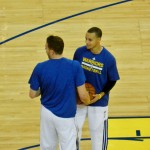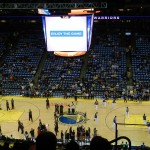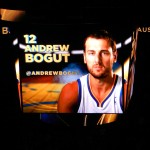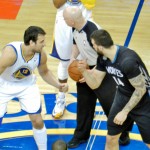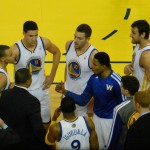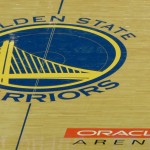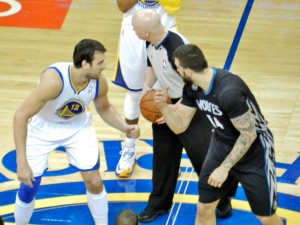 Despite their second-round series loss to the San Antonio Spurs, the 2013 NBA playoffs were truly a coming-out party for Stephen Curry and the Golden State Warriors. Since 1994—basically a generation—the Warriors had been one of the least relevant franchises in all of sports, with the exception of an upset against the Dallas Mavericks in 2007 on the one occasion during that period when their season extended beyond the regularly scheduled 82 games. Few NBA fans, as a result, would have anticipated what they saw last April and May: a Warriors team led by the incendiary shooting of Curry that beat the Denver Nuggets and gave the eventual conference champion Spurs all the competition they could handle before losing in six games. The Oracle Arena had not seen this amount of electricity since Hall-of-Fame forward Rick Barry shot free throws in his trademark granny style in the 1970s (apologies to the Run TMC teams of the late 80s and early 90s). This was a show, I decided, that I needed to see in person.
Despite their second-round series loss to the San Antonio Spurs, the 2013 NBA playoffs were truly a coming-out party for Stephen Curry and the Golden State Warriors. Since 1994—basically a generation—the Warriors had been one of the least relevant franchises in all of sports, with the exception of an upset against the Dallas Mavericks in 2007 on the one occasion during that period when their season extended beyond the regularly scheduled 82 games. Few NBA fans, as a result, would have anticipated what they saw last April and May: a Warriors team led by the incendiary shooting of Curry that beat the Denver Nuggets and gave the eventual conference champion Spurs all the competition they could handle before losing in six games. The Oracle Arena had not seen this amount of electricity since Hall-of-Fame forward Rick Barry shot free throws in his trademark granny style in the 1970s (apologies to the Run TMC teams of the late 80s and early 90s). This was a show, I decided, that I needed to see in person.
I finally made it to Oracle just over a week ago to see the Warriors play the Minnesota Timberwolves, a team that had struggled for much of the year but had started to win of late. The Warriors had mostly picked up where they left off last season, including a ten-game winning streak in December and January that featured a road victory over the 2013 NBA champion Miami Heat. More recently, however, the Warriors had struggled due to a tough schedule and some injuries. I was not even sure I would see two of the Warriors’ starters, center Andrew Bogut and forward David Lee, both of whom had injured themselves during their loss to the Indiana Pacers the previous Monday. Not that I subscribe to the Vince Lombardi school of sports medicine,* but I admit I was glad to see them on the floor for pre-game warm-ups.
Once the game started, it didn’t take long to see that we would be treated to a track meet, where defense would be low on the priority list. The T-Wolves jumped out to a lead, but the Warriors came back to tie the game at the end of the first period. The game was also tied 63-63 at halftime, almost a full game’s worth of points for many of the Pat Riley-coached New York Knicks teams of the 1990s. With all of the offensive fireworks on the court, one might think that nothing else would have been necessary to keep the fans’ attention, but NBA teams apparently operate under the assumption that even the slightest moment of down time might induce people to get bored and not renew their season tickets. As a result, every time-out featured some kind of special attraction, such as Warrior cheerleader dance routines, free-throw contests, trampoline dunking exhibitions, and T-shirts shot out of a cannon into the crowd. It was a far higher-octane environment that I was used to from attending Giants baseball games, but I didn’t mind. Sometimes it’s nice to have people work overtime to keep you entertained.
The biggest attraction of the evening, though, was Stephen Curry. He is relatively tall in the real world—about 6’3”, but he looks very small on an NBA court. It could be a problem for him on defense, but on offense his quickness and ball-handling skills enabled him to rack up assists with nifty passes and get open for shots anywhere on the court, particularly behind the arc. There he was 6 for 10 for the night, and when he would launch one of his 3-point shots we would all watch the ball anxiously, then yell deliriously when it swished through the net. “Steeeepheeeeennnn Cuuuuurrrryyyy!!!!” the announcer would intone after each of these shots. These were the moments I had most eagerly anticipated before the game, and as they occurred I thought that someday Curry would probably end up in the Hall of Fame, and I would be able to say that I was there to see him at his finest. More than just about anything else, I live for this kind of thing, which probably explains my attraction to professional sports.
The game ended up going to the wire. The Warriors took a one-point lead with 27 seconds remaining, but they couldn’t stop the T-Wolves from scoring on the next possession and ended up down a point with the ball and eight seconds left. The in-bounds pass went to Curry, of course, but the T-Wolves double-teamed him and forced him to pass to Harrison Barnes who was open on the baseline. Unfortunately, Barnes’ shot clanked off the rim. The buzzer sounded, and that was it for the night. Exhilarated despite the loss, we somehow made it out of our upper deck seats to the car in about five minutes and, due to my brother’s foresight in parking at the outer edge of the lot, were on the freeway within ten. It is probably the fastest time I’ve ever recorded in getting out of a sporting event.
A wonderful evening, and we all agreed that we should do this again next year. I could definitely make it a habit.
* Ray Nitschke, the Hall-of-Fame linebacker for the Green Bay Packers, once came to the sideline during a game and told Lombardi, “Coach, I broke my hand.” Lombardi yelled, “Get back in there! The other team doesn’t know that!”
– Chuck Strom
